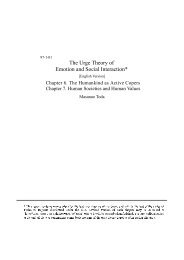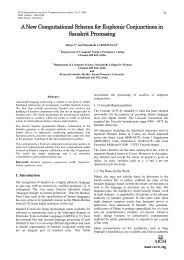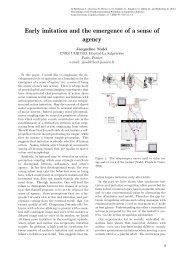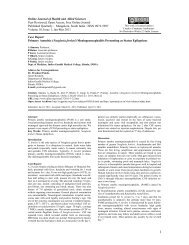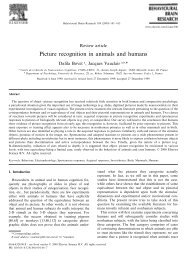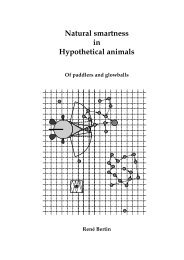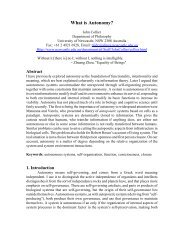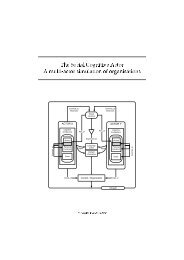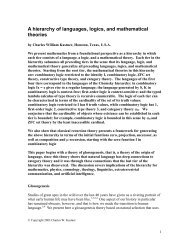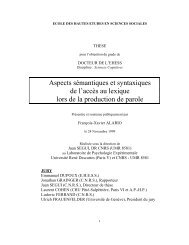Development of a Hindi Lemmatizer - arXiv
Development of a Hindi Lemmatizer - arXiv
Development of a Hindi Lemmatizer - arXiv
You also want an ePaper? Increase the reach of your titles
YUMPU automatically turns print PDFs into web optimized ePapers that Google loves.
International Journal <strong>of</strong> Computational Linguistics and Natural Language Processing Vol 2 Issue 5 May 2013<br />
ISSN 2279 – 0756<br />
<strong>Development</strong> <strong>of</strong> a <strong>Hindi</strong> <strong>Lemmatizer</strong><br />
Snigdha Paul #1 , Nisheeth Joshi #2 , Iti Mathur #3<br />
# Apaji Institute, Banasthali University, Rajasthan, India<br />
1<br />
snigdha.pal18@gmail.com<br />
nisheeth.joshi@rediffmail.com<br />
3<br />
mathur_iti@rediffmail.com<br />
2<br />
Abstract— We live in a translingual society, in order to<br />
communicate with people from different parts <strong>of</strong> the world we<br />
need to have an expertise in their respective languages. Learning<br />
all these languages is not at all possible; therefore we need a<br />
mechanism which can do this task for us. Machine translators<br />
have emerged as a tool which can perform this task. In order to<br />
develop a machine translator we need to develop several<br />
different rules. The very first module that comes in machine<br />
translation pipeline is morphological analysis. Stemming and<br />
lemmatization comes under morphological analysis. In this paper<br />
we have created a lemmatizer which generates rules for<br />
removing the affixes along with the addition <strong>of</strong> rules for<br />
creating a proper root word.<br />
Keywords— lemmatizer, lemmatization, inflectional, derivational.<br />
I. INTRODUCTION<br />
Morphological analysis is one <strong>of</strong> the most important part<br />
<strong>of</strong> linguistic analysis where we study the structure <strong>of</strong> words.<br />
This analysis is used to segment the words into morphemes.<br />
For the analysis <strong>of</strong> text in any language morphological<br />
analyzer is one <strong>of</strong> the foremost step. When we talk about<br />
language the first thing that comes in our mind is a “Word.”<br />
Language is vast and has a huge diversification in words.<br />
These words make up a language. So in order to have<br />
knowledge about any language we need to know about its<br />
word structure. Language like <strong>Hindi</strong> is morphologically rich<br />
and need a keen analysis <strong>of</strong> words so that we can acquire its<br />
meaning and grammatical information. Lemmatization is the<br />
most important part <strong>of</strong> morphological analysis. With<br />
lemmatization we come to know the root word. Further by<br />
applying morphological tactics all the features <strong>of</strong> a particular<br />
word is shown. Morphology shows all the features <strong>of</strong> a<br />
particular word. By this analysis we come to know the<br />
category, gender, number, case, etc. thus we get all the<br />
information about a word which tend us to understand the<br />
language.<br />
Morphology has two main broad classes: inflectional<br />
morphology and derivational morphology. Inflectional<br />
morphology is the study <strong>of</strong> those words which when inflected<br />
does not change the class and is formed from the existing stem,<br />
for example - we have a word खज़ाना which when added with<br />
a suffix becomes खज़ानची. The derived word doesn’t change<br />
its word class that is both खज़ाना and खज़ानची belong to noun<br />
class. Derivational morphology is the study <strong>of</strong> those words<br />
which when inflected changes the class and new word<br />
formation takes place from the existing stem, for example –<br />
the word सजा when suffixed with वट gives a derived word<br />
सजावट which belongs to a different class, that is the word<br />
सजा is verb but when suffixed, gives us noun सजावट).Thus<br />
(सजावट<br />
we have root words which are affixed with several<br />
morphemes. Generally when we look up a dictionary we get<br />
almost all the root words but their derivated forms are rarely<br />
found.<br />
To overcome this problem we have morphological<br />
analyzer. The analyzer is a way to get the derivated word from<br />
the root thereby giving its features. In this paper we aim to<br />
develop a tool for executing the inflectional analysis <strong>of</strong> <strong>Hindi</strong><br />
by using rule based approach. In this approach, in order to<br />
obtain the suffix list the foremost thing that we did is the study<br />
<strong>of</strong> various <strong>Hindi</strong> words. After getting the suffix list we created<br />
rules. These rules also include the addition and deletion <strong>of</strong><br />
characters to make the word a proper root or stem. Here we do<br />
not emphasize on the grammatical information <strong>of</strong> the words<br />
which are categorized as number, person and gender. Along<br />
with this analysis the rest <strong>of</strong> the paper includes linguistic<br />
background <strong>of</strong> <strong>Hindi</strong>. Approach that we have applied is,<br />
generation <strong>of</strong> suffixes and rules.<br />
II. RELATED WORK<br />
A lot <strong>of</strong> research work has been done and is still going on for<br />
the development <strong>of</strong> a stemmer as well as lemmatizer. The first<br />
stemmer was developed by Julie Beth Lovins [12] in 1968.<br />
Later the stemmer was improved by Martin Porter [11] in July,<br />
1980 for English language. The proposed algorithm is one <strong>of</strong><br />
the most accepted methods for stemming where automatic<br />
removal <strong>of</strong> affixes is done from English words. The algorithm<br />
has been implemented as a program in BCPL. Much work has<br />
been done in developing the lemmatizer <strong>of</strong> English and other<br />
European languages. In contrast, very little work has been<br />
done for the development <strong>of</strong> lemmatization for Indian<br />
languages. A rule based approach proposed by Plisson et al.<br />
[10] is one <strong>of</strong> the most accepted lemmatizing algorithms. It is<br />
based on the word endings where the suffix should be<br />
removed or added to get the normalized form. It emphasizes<br />
on two word lemmatization algorithm which is based on ifthen<br />
rules and the ripple down approach. The work proposed<br />
by Goyal et al. [1] focuses on the development <strong>of</strong> a<br />
morphological analyzer and generator. They aimed to develop<br />
a translation system especially from <strong>Hindi</strong> to Punjabi. Nikhil<br />
K V S [5] built a <strong>Hindi</strong> derivational analyzer using a specific<br />
Snigdha Paul et.al.<br />
380<br />
www.ijclnlp.org
International Journal <strong>of</strong> Computational Linguistics and Natural Language Processing Vol 2 Issue 5 May 2013<br />
ISSN 2279 – 0756<br />
tool. He used supervised approach by creating a SVM<br />
classifier. Jena et al. [6] proposed a morphological analyzer<br />
for Oriya language by using the paradigm approach. They<br />
classified nouns, adjectives and finite verbs <strong>of</strong> Oriya by using<br />
various paradigm tables. Anand Kumar et al. [4] developed an<br />
automatic system for the analysis <strong>of</strong> Tamil morphology. They<br />
used various methodologies, rule based approach and<br />
sequence labelling containing the non linear relationships <strong>of</strong><br />
morphological features from the training data in a better way.<br />
Chachoo et al. [3] used an extract tool named Extract v2.0<br />
for the development <strong>of</strong> the orthographic component <strong>of</strong><br />
Kashmiri Script. A method has been proposed by Majumder et<br />
al. [9] in which a clustering based approach is used for<br />
discovering the equivalent classes <strong>of</strong> root words. This<br />
algorithm was tested for two languages French and Bangla. A<br />
rule based approach for stemming in <strong>Hindi</strong> was proposed by<br />
Ramanathan & Rao [8]. The approach is based on stripping<br />
<strong>of</strong>f suffixes by generating rules emphasizing on noun,<br />
adjective and verb inflections in <strong>Hindi</strong>. Bharti Akshar et al. [2]<br />
proposed the work on natural language processing where they<br />
gave a detailed study <strong>of</strong> morphology using paradigm approach.<br />
Gupta et al. [13] proposed unsupervised approach for<br />
stemming where they have used partial lemmatization along<br />
with some database. They aimed to improve unsupervised<br />
stemming by removing over-stemming problem. Mohd.<br />
Shahid Husain [14] developed a stemmer by using<br />
unsupervised approach. He used two different approaches<br />
frequency based and length based method for suffix stripping<br />
where he used Emille corpus for Urdu and Marathi languages.<br />
III. LINGUISTIC BACKGROUND OF HINDI<br />
Morphemes play a major role in morphology. This is the<br />
major way in which morphologists investigate words, then<br />
internal structure and their formation. Morphology is broadly<br />
categorized into two parts: derivational morphology and<br />
inflectional morphology. Derivational morphology processes<br />
the words and form new lexemes from the existing ones. This<br />
is done by either adding or deleting affixes. For example –<br />
सचा + ई = सचाई. The class <strong>of</strong> the word is changed from<br />
adjective to noun. Similarly, in English we have words like<br />
computer + ization = computerization, where the class is<br />
changed from noun to adjective. Inflectional morphology<br />
processes the words by producing various inflections without<br />
changing the word class. For example – कताब + ◌े◌ं = कताब<br />
where कताब is noun/singular while कताब is noun/plural.<br />
The class remains same here. The root form <strong>of</strong> the words<br />
basically comes under noun and verb classes. This knowledge<br />
lead us to trace the paradigm approach. According to Smriti<br />
Singh and Vaijayanthi M Sarma [7], <strong>Hindi</strong> noun classification<br />
system shows only the number and case for morphological<br />
analysis. Number basically includes either singular or plural.<br />
By default we keep the number <strong>of</strong> a word as singular. Case on<br />
<strong>Hindi</strong> words is <strong>of</strong> two types – direct and oblique. Oblique<br />
words show the case as well as the number <strong>of</strong> the word. For<br />
example – लड़क – ◌ा, लड़क – ◌े, here ◌ा shows singular<br />
number whereas ◌े shows plural number. Similarly we also<br />
have some gender rules. In <strong>Hindi</strong>, words that end with the<br />
suffix ◌ी are marked feminine whereas the words that end<br />
with suffix ◌ा are marked as masculine. For example लड़का is<br />
masculine ending with ◌ा while लड़क is feminine ending with<br />
◌ी. But there are many words that contradict this concept. For<br />
example – we have the word पानी (water) which is masculine<br />
although it is ending with ◌ी. Similarly we have another word<br />
माला (garland) which is feminine even though ending with ◌ा.<br />
There are also some words which has the suffix that cannot be<br />
removed. For example – let us consider the suffix ◌ा, the<br />
words पता, माता, बचा, कटोरा, नेता, and many more does not<br />
require stemming. Such words need to be maintained as it is<br />
and should be refrained from being stemmed. So we find that<br />
<strong>Hindi</strong> is a highly inflected language which needs the deep<br />
study <strong>of</strong> word structure and its formation.<br />
IV. PROPOSED WORK<br />
In this paper we have discussed about the creation <strong>of</strong> a<br />
<strong>Hindi</strong> lemmatizer. Our approach is based on the key concept<br />
<strong>of</strong> optimization. Optimization includes both space and time, so<br />
our approach is based on these parameters. The lemmatizer<br />
that we discuss here mainly focuses on the time complexity.<br />
Typically a lemmatizer is built using rule based approach. In<br />
rule based approach along with the rules, knowledgebase is<br />
created for storing the grammatical features. Although the<br />
knowledgebase creation requires a large amount <strong>of</strong> memory,<br />
but in respect <strong>of</strong> time it gives us the best, accurate and fast<br />
result. The reason behind this fast retrieval is that, a very short<br />
time is taken to search the input word from the knowledgebase.<br />
A study has been conducted in Tamil which shows that Tamil<br />
words have infinite set <strong>of</strong> inflections but <strong>Hindi</strong> words have<br />
finite set <strong>of</strong> inflections which are quite easy to maintain in the<br />
knowledgebase. We have restricted our knowledgebase to<br />
commonly used words which do not contain the proper nouns<br />
like the names <strong>of</strong> person and place.<br />
A. Approach Used<br />
Although there are many approaches for performing<br />
lemmatization like supervised approach, rule based approach,<br />
unsupervised approach, but among these approaches rule<br />
based approach is one <strong>of</strong> the most acceptable approach. We<br />
have used rule based approach for extracting the suffixes. In<br />
rule based approach we have created many different rules for<br />
eliminating the suffixes. Since rule based approach totally<br />
works according to the rules therefore there is a less chance <strong>of</strong><br />
error in obtaining the output. Rule based approach also<br />
optimizes the work by which we can get the result in a blink<br />
<strong>of</strong> an eye.<br />
B. Suffix Generation<br />
For the development <strong>of</strong> a lemmatizer we have gone<br />
through various words with their suffixes and examined the<br />
Snigdha Paul et.al.<br />
381<br />
www.ijclnlp.org
International Journal <strong>of</strong> Computational Linguistics and Natural Language Processing Vol 2 Issue 5 May 2013<br />
ISSN 2279 – 0756<br />
morphological changes. These suffixes and changes led to the<br />
development <strong>of</strong> specific rules. For example – If we take the<br />
word कमज़ोर (weakness) then we find that the word is<br />
derived by adding ◌ी suffix. Similarly there are many other<br />
words with the same suffix. Some <strong>of</strong> them are shown in Table<br />
I and II<br />
TABLE I<br />
EXAMPLE OF DERIVED WORDS WITH SUFFIX ◌ी<br />
Root Word<br />
कमज़ोर<br />
खुश<br />
गरम<br />
गरब<br />
सद<br />
TABLE II<br />
Derived Word<br />
कमज़ोर<br />
खुशी<br />
गम<br />
गरबी<br />
सद<br />
SOME MORE SUFFIXES<br />
Root Word Derived Word Suffix<br />
लड़क लड़कया ◌या<br />
साफ़ सफ़ाई ई<br />
गंभीर गंभीरता ता<br />
Fig. 1 Working <strong>of</strong> a Rule<br />
Table III illustrates this process.<br />
TABLE III<br />
WORDS SHOWING THE SUFFIX ◌ो◌ं<br />
Word Root Extraction <strong>of</strong><br />
suffix<br />
Rule application<br />
लड़क लड़का ◌ो◌ं ◌ा<br />
बालक बालक ◌ो◌ं __<br />
नागरक नागरक ◌ो◌ं __<br />
Addition <strong>of</strong><br />
character<br />
In the above table on removing the suffix ◌ो◌ं we get their<br />
respective root word. But the word लड़क is an exception here<br />
because on removing the suffix ◌ो◌ं we need to add ◌ा to the<br />
last letter <strong>of</strong> the word to make it a genuine root word’ लड़का.’<br />
Similarly there are many other rules for removing the suffix<br />
and if necessary addition <strong>of</strong> character may also take place.<br />
Similarly we also have some other rules, like the rule for<br />
extracting the suffix ◌य which is shown in Table IV.<br />
TABLE IV<br />
WORDS SHOWING THE SUFFIX ◌य<br />
Rule application<br />
सौदा सौदागर गर<br />
कचा कचापन पन<br />
पढ़ पढ़ाई ◌ाई<br />
असली असिलयत इयत<br />
Word Root Extraction <strong>of</strong><br />
suffix<br />
लड़कय लड़क ◌य ◌ी<br />
कहािनय कहानी ◌य ◌ी<br />
Addition<br />
character<br />
<strong>of</strong><br />
Since the work has been done manually therefore this<br />
phase was quite time consuming. The suffixes were generated<br />
by processing a corpus <strong>of</strong> 20,000 sentences from which 55<br />
lakh words were manually stemmed out <strong>of</strong> which 112 suffixes<br />
were derived.<br />
C. Rule Generation<br />
After the generation <strong>of</strong> suffix list we have developed rules.<br />
We have created 112 rules which are framed in such a way<br />
that the suffix gets removed from the input word and if<br />
required, addition <strong>of</strong> character or ‘maatra’ takes place. For<br />
example – let us take the suffix ◌ो◌ं. Fig 1 shows the working<br />
<strong>of</strong> the rule for this suffix.<br />
लड़क Ð ◌ो◌ं + ◌ा = लड़का<br />
सड़क Ð ◌ो◌ं = सड़क<br />
कवय कव ◌य ◌ (exception)<br />
िचड़य िचड़या ◌य ◌या<br />
(exception)<br />
Since we know that in <strong>Hindi</strong>, when we remove the<br />
plural, we need to add ◌ी to the last letter <strong>of</strong> the word. This is<br />
the general grammar rule. Table 4 mentions the rule for the<br />
suffix ◌य in which we have created a general rule for<br />
removing the suffix and adding ◌ी to the word, but we have<br />
some exceptions here which include the addition <strong>of</strong> ◌ instead<br />
<strong>of</strong> ◌ी. In the above table we have also shown an exception in<br />
the last word िचड़य where the root form is िचड़या. This<br />
Snigdha Paul et.al.<br />
382<br />
www.ijclnlp.org
International Journal <strong>of</strong> Computational Linguistics and Natural Language Processing Vol 2 Issue 5 May 2013<br />
ISSN 2279 – 0756<br />
word contains two suffixes together which are ◌य and ◌ो◌ं.<br />
This becomes hard for the system as it finds difficulty in<br />
picking up the correct rule for the particular word. Similarly<br />
there are many more exceptions for which we have generated<br />
different rules. To overcome such problems we have built a<br />
database in which such exceptional words are kept. Although<br />
this work requires much time but for the sake <strong>of</strong> fast and<br />
accurate result this approach is applied. The rule is shown in<br />
Fig 2-<br />
If (root) present in (knowledgebase)<br />
{<br />
Fetch the root from the list<br />
Display;<br />
}<br />
else if (root) not present in (knowledgebase)<br />
{<br />
If (source) ends with (suffix)<br />
{<br />
Substring the source<br />
Display the root;<br />
}<br />
}<br />
Fig. 2 Rule procedure<br />
D. Algorithmic Steps<br />
The input word is first checked in database. If the word<br />
exists in the database then it is displayed as output but if the<br />
word doesn’t exist in the database then the rules are accessed<br />
for stripping out the suffix. The rules work by deleting the<br />
suffix from the input. After deletion, if the word provides a<br />
proper meaning then it is displayed as a result otherwise a<br />
particular character or matra is added to the stripped word to<br />
make it a proper meaningful word. The steps are shown in Fig<br />
3.<br />
1. Check input word in knowledgebase.<br />
2. Display if exist.<br />
3. Otherwise access the rules.<br />
4. Generate suffix stripping rules<br />
i. Delete the suffix.<br />
ii. Delete & add characters.<br />
Some <strong>of</strong> the input words are shown in Fig 4-<br />
नज़र, सड़क, लड़क, लड़कयाँ, खुशी, भारतीयता, मजदूर, िमठाई,<br />
बािलकाओं, िननीय, गौरवांवत, सफलताओं, लड़क, मंज़ल, वदा,<br />
यादा, पढ़ाई, कवय, ितजोरय, सतरंगी, आतंकय, बुनाई,<br />
नकारामक, नेताओं, अपमािनत, िचड़य, संशोधन, शशाली,<br />
शीलय.<br />
Fig. 4 Snapshot <strong>of</strong> inputs<br />
The output <strong>of</strong> some <strong>of</strong> these words are shown in Table V-<br />
TABLE V<br />
SEPARATED LEMMA AND SUFFIXES<br />
Lemma<br />
Suffix<br />
नज़र<br />
◌े◌ं<br />
सड़क<br />
◌ो◌ं<br />
लड़क -<br />
खुश<br />
◌ी<br />
भारत<br />
◌ीयता<br />
मजदूर<br />
◌ी<br />
बािलका<br />
ओं<br />
वास<br />
नीय<br />
सफल<br />
ताओं<br />
लड़का<br />
◌ो◌ं<br />
संशोध<br />
न<br />
ितजोर<br />
य<br />
लड़क<br />
◌याँ<br />
यादा -<br />
Some <strong>of</strong> the wrong output words are shown in Fig 5-<br />
ववेचना, उोगपित, ककार, ककार, आयामक, ानामक, कलाित,<br />
शांितयता, िमान, गुणवा, गुणकार, िनरंतर, नकलची, िनंदनीय,<br />
जनामक, सौभायशाली, वावलंबन, तमनाएं, णत, दयालु, चौकदार,<br />
चमकला, वधुतीकरण.<br />
Fig. 3 Algorithm<br />
V. EVALUATION<br />
The system is evaluated for its accuracy where we gave<br />
500 words for lemmatization. Among these 500 words 456<br />
words were correctly lemmatized and 44 words were incorrect<br />
because they violated both the exceptional and general rules.<br />
Accuracy <strong>of</strong> the system was computed using the following<br />
equation-<br />
Accuracy= 91%<br />
Fig. 5 Snapshot <strong>of</strong> errors<br />
VI. CONCLUSION<br />
In this paper we have discussed the development <strong>of</strong> a<br />
lemmatizer for <strong>Hindi</strong>. The work uses the rule based approach<br />
by creating knowledgebase which contains all the <strong>Hindi</strong> words<br />
that are commonly used in day to day life. The approach also<br />
emphasized on time optimization problem rather than on<br />
space. Since nowadays space is not at all a big problem,<br />
therefore our approach aimed to optimize time and generate<br />
accurate result in a very short period. Our system gave 91% <strong>of</strong><br />
accuracy.<br />
Snigdha Paul et.al.<br />
383<br />
www.ijclnlp.org
International Journal <strong>of</strong> Computational Linguistics and Natural Language Processing Vol 2 Issue 5 May 2013<br />
ISSN 2279 – 0756<br />
REFERENCES<br />
[1] Vishal Goyal and Gurpreet Singh Lehal, “<strong>Hindi</strong> Morphological and<br />
Generator,” IEEE Computer Society Press California USA, pp. 1156-<br />
1159, 2008.<br />
[2] Bharti Akshar, Vineet Chaitanya and Rajeev Sangal, The Natural<br />
Language Processing:A Paninian Perspective, 1995.<br />
[3] Manzoor Ahmed Chachoo and S.M.K Quadri, “Morphological<br />
Analysis from the raw Kashmiri Corpus Using Open Source Extract<br />
Tool,” Vol. 7, No. 2, 2011.<br />
[4] Anand Kumar M, Dhanlakshmi V and Sonam K.P, “A sequence<br />
labeling approach to morphological analyzer for tamil language,”<br />
International Journal on Compter Science and Engineering, Vol. 02,<br />
No. 06, 2010.<br />
[5] Nikhil K V S, “<strong>Hindi</strong> derivational morphological analyzer,” Language<br />
Technologies Research Center, IIIT Hyderabad, 2012<br />
[6] Itisree Jena, Sriram Chaudhary, Himani Chaudhary and Dipti M.<br />
Sarma,”Developing Oriya Morphological Analyzer Using Lt-toolbox,”<br />
ICISIL 2011, CCIS 139, pp. 124-129, 2011.<br />
[7] Smriti Singh and Vaijayanti M Sarma, “<strong>Hindi</strong> Noun Inflection and<br />
Distributed Morphology.”<br />
[8] A. Ramnathan, D Rao, “A lightweight Stemmer for <strong>Hindi</strong>,” In<br />
Proceedings <strong>of</strong> Workshop on Computational Linguistics for South<br />
Asian Languages, 10 th Conference <strong>of</strong> the European Chapter <strong>of</strong><br />
Association <strong>of</strong> Computational Linguistcs. pp 42-48. 2003.<br />
[9] Prasenjit Majumder, Mandar Mitra, swapan k. Pauri, Gobinda Kole,<br />
Pabitra Mitra and Kalyankumar Datta, YASS: Yet Another Suffix<br />
Stripper, ACM Transactions on Information Systems, Vol.25, No.4, pp.<br />
18-38,2007.<br />
[10] Plisson, J, Larc, N, Mladenic, “A Rule based approach to word<br />
lemmatization,” Proceedings <strong>of</strong> the 7 th International Multiconference<br />
Information Society, IS-2004, Institute Jozef Stefan, Ljubljana, pp.83-<br />
86,2008.<br />
[11] Martin F. Porter, An algorithm for suffix stripping, Program, Vol. 14,<br />
No. 3, pp 130-137, 1980.<br />
[12] Julie Beth Lovins, <strong>Development</strong> <strong>of</strong> stemming Algorithm, Mechanical<br />
Translation and Computational Linguistics, Vol. 11, No. 1, pp 22-23,<br />
1968.<br />
[13] Deepa Gupta, Rahul Kumar Yadav, Nidhi Sajan, “Improving<br />
Unsupervised Stemming by using Partial Lemmatization Coupled with<br />
Data-Based Heuristics for <strong>Hindi</strong> ,” International Journal <strong>of</strong> Computer<br />
Application(0975-8887), Vol. 38, No. 8, January 2012.<br />
[14] Mohd. Shahid Hussain, “An unsupervised approach to develop<br />
stemmer,” International Journal on Natural Language Computing, Vol.<br />
1, No. 2, August 2012.<br />
Snigdha Paul et.al.<br />
384<br />
www.ijclnlp.org



